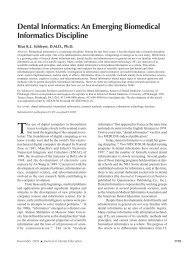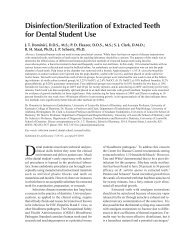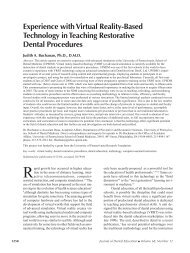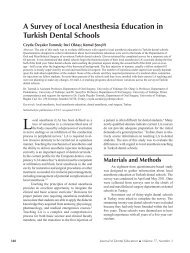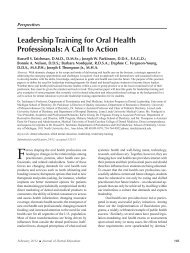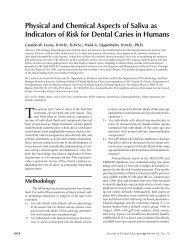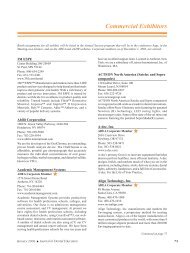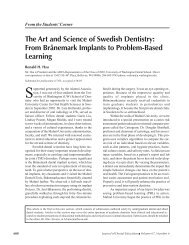List of Poster Presentations - Journal of Dental Education
List of Poster Presentations - Journal of Dental Education
List of Poster Presentations - Journal of Dental Education
You also want an ePaper? Increase the reach of your titles
YUMPU automatically turns print PDFs into web optimized ePapers that Google loves.
<strong>Poster</strong> Abstracts<br />
universities in Georgia are invited. The program is held on a Saturday.<br />
The Dean <strong>of</strong> the SOD and SNDA members welcome the students.<br />
Information is presented on admission, financial aid and minority<br />
affairs. There is a keynote speaker, lunch, and tour. <strong>Dental</strong> students<br />
serve as role models in making impressions and pouring casts <strong>of</strong> the<br />
participants’ dentitions. There is a panel discussion also. The SNDA<br />
members give t-shirts as mementos. There is not an <strong>of</strong>ficial attendance<br />
for 1999, but approximately 18 undergraduate students attended. In<br />
2000, 18 undergraduate and 2 high school students attended. In 2001,<br />
6 undergraduate, 22 high school and 22 middle school students<br />
attended. The attendance reveals an increase in younger students and<br />
a decrease in undergraduate students from 1999-2001. The decrease<br />
in the undergraduates may be due to the lack <strong>of</strong> publicity on campuses<br />
and in the communities. This decrease was not expected and MCG<br />
will continue to attract this population through more aggressive<br />
methods. The increase in secondary students is positive. At this level<br />
students are provided the opportunity <strong>of</strong> early planning for a career<br />
in dentistry. At the NDA convention in 2000 the IMPRESSIONS<br />
Program was proposed as a national project. As <strong>of</strong> 2001 there are two<br />
dental students enrolled that are former participants.<br />
The IMPRESSIONS Program is one <strong>of</strong> many URM recruitment<br />
efforts provided by the SNDA at the Medical College <strong>of</strong> Georgia<br />
School <strong>of</strong> Dentistry. The primary goal is to establish a strong pipeline<br />
<strong>of</strong> URM interested in attending dental school. As the only minority<br />
student organization in the dental school, the SNDA is driven to<br />
increase the number <strong>of</strong> URM that graduate from accredited dental<br />
schools in order to practice in underserved rural areas. In doing so, it<br />
is believed that the access to and quality <strong>of</strong> dental care for all minorities<br />
will increase. Participants will continue to be tracked for several years<br />
in order to assess whether the IMPRESSIONS Program influenced<br />
their ultimate career paths.<br />
33. Trends in Student Gender Composition During<br />
UKCD Institutional History... 25 Year Perspective<br />
Osborne, Paul B., University <strong>of</strong> Kentucky College <strong>of</strong> Dentistry, Skelton,<br />
Judith NMI, University <strong>of</strong> Kentucky College <strong>of</strong> Dentistry<br />
The purpose <strong>of</strong> this work is to document the changes in gender<br />
demographics for each dental student class from the first class at<br />
UKCD through the present first year class.<br />
The 1962 Hollinshead report <strong>of</strong> the Commission on the Survey<br />
<strong>of</strong> Dentistry in the United States in 1962 documented that women<br />
represented a very small percentage <strong>of</strong> U.S. dentists compared to other<br />
countries. It reported that in 1958, the United States dentists had but<br />
a 1% representation <strong>of</strong> females compared to other countries lead by<br />
Lithuania, Latvia, Finland and Russia where respectively 96%, 93%<br />
80% and 71 percent <strong>of</strong> the pr<strong>of</strong>ession were women. The University<br />
<strong>of</strong> Kentucky College <strong>of</strong> Dentistry (UKCD) opened it’s doors in 1963<br />
with a typically totally male class. Two years later, the first female<br />
dental student was admitted with the 1965 entering class to set the<br />
hallmark. Following a U.S. national trend, UKCD has seen a steady<br />
increase in females graduating peaking in 1994 with 58.1% <strong>of</strong> the<br />
class being women during a time when the class sizes were somewhat<br />
diminished in overall student enrollments. As the College has returned<br />
to more normal enrollment size in recent years, women graduates<br />
stabilized roughly around 40%. Currently enrolled classes dropped<br />
to 28.0% and 34.6% with the 4th and 2nd year classes, but a more<br />
representative number with 41.2% and 48% enrolled in the 3rd and<br />
1st year classes. The University <strong>of</strong> Kentucky has long supported the<br />
national trend <strong>of</strong> increasing numbers <strong>of</strong> women in the pr<strong>of</strong>ession <strong>of</strong><br />
dentistry and salutes their many contributions.<br />
Women in the field <strong>of</strong> dentistry has greatly increased in the<br />
past four decades. This increase has been mirrored at the University<br />
<strong>of</strong> Kentucky College <strong>of</strong> Dentistry during this same time period and<br />
continues with recently graduated classes and currently enrollees.<br />
34. Retrospective Study <strong>of</strong> Oral Pemphigoid<br />
Paek, Shirley E., University <strong>of</strong> Michigan School <strong>of</strong> Dentistry, D’Silva,<br />
Nisha J., University <strong>of</strong> Michigan School <strong>of</strong> Dentistry, Gobetti, John<br />
P., University <strong>of</strong> Michigan School <strong>of</strong> Dentistry<br />
The purpose <strong>of</strong> this study was to review and reclassify BMMP<br />
patients seen over the last five years in an Oral Medicine Clinical Practice.<br />
Benign Mucous Membrane Pemphigoid (BMMP) is a<br />
vesiculobullous autoimmune disease. BMMP occurs primarily in older<br />
women. As the geriatric population increases, dentists will face the<br />
challenge <strong>of</strong> diagnosing and managing BMMP patients. BMMP was<br />
suggested to be reclassified by clinical presentation; Bullous<br />
Pemphigoid (BP), Cicatricial Pemphigoid (CP), Oral Mucous<br />
Membrane Pemphigoid (OMMP), and Ocular Pemphigoid. BP<br />
exhibits epidermal lesions, CP affects multiple mucosal sites with/<br />
without epidermal involvement. OMMP and Ocular Pemphigoid<br />
involve oral or ocular membranes. The purpose <strong>of</strong> this study was to<br />
review and reclassify BMMP patients seen over the last five years in<br />
an Oral Medicine Clinical Practice. Data collected were: gender, age,<br />
clinical signs, presence <strong>of</strong> Nikolsky’s sign, histopathology and<br />
immunopathology results, oral symptoms, systemic presentation,<br />
degree <strong>of</strong> severity and treatment. Results: Of 729 cases reviewed,<br />
diagnosis <strong>of</strong> BMMP in 29 cases (4%). Of the 29 cases, 93% OMMP,<br />
7% CP. 60% were female and 83% 50 years or older at onset. Common<br />
sites were gingiva (90%) and buccal mucosa (30%). 63% exhibited<br />
erosive or ulcerated lesions. 35% showed a positive Nikolsky’s sign.<br />
84% <strong>of</strong> biopsied patients (25) diagnosed on histologic findings.<br />
Immun<strong>of</strong>luorescence studies (18), 77% tested positive for antibodies.<br />
59% had 2 or more lesions, controlled with topical steroids.<br />
Conclusions: Most patients presenting to the dental <strong>of</strong>fice will exhibit<br />
oral but no systemic lesions and hence would be classified as OMMP.<br />
The data suggest that histopathologic evaluation is effective for<br />
diagnosis. A larger population group would be required for a more<br />
definitive conclusion. This study was supported by the University <strong>of</strong><br />
Michigan Student Research Program.<br />
Most patients presenting to the dental <strong>of</strong>fice will exhibit oral<br />
but no systemic lesions and hence would be classified as OMMP.<br />
Histopathologic evaluation is effective for diagnosis.<br />
35. Clinic Information System Technical Implementation<br />
Pearson, Robert J., Oregon Health and Science University School <strong>of</strong><br />
Dentistry, Stewart, Denice CL., Oregon Health and Science University<br />
School <strong>of</strong> Dentistry, Monner, Melissa, Oregon Health and Science<br />
University School <strong>of</strong> Dentistry, Russell, Rose, Oregon Health and<br />
Science University School <strong>of</strong> Dentistry, Lloyd, Mary, Oregon Health<br />
and Science University School <strong>of</strong> Dentistry, Morita, Peter, Oregon<br />
Health and Science University School <strong>of</strong> Dentistry, Clinton, Jack,<br />
Oregon Health and Science University School <strong>of</strong> Dentistry<br />
Purpose: To migrate a clinic management system from a<br />
proprietary system developed in-house, to a commercially produced<br />
s<strong>of</strong>tware package that <strong>of</strong>fers a greater degree <strong>of</strong> functionality,<br />
flexibility, and security than the previous system.<br />
Significance: Conversion from a school-developed clinic<br />
information system to a more extensive commercially developed<br />
system, is a process faced by many dental schools. Designing the<br />
appropriate infrastructure is critical to the success <strong>of</strong> the conversion.<br />
Methodology: 1) Assess old system: determine usage patterns;<br />
hardware/s<strong>of</strong>tware configurations for client and server side; and<br />
growth metrics for the existing database; Determine approximation<br />
<strong>of</strong> required resources (e.g., amount <strong>of</strong> disk, memory, and network<br />
bandwidth); Determine data to be extracted. Script out and review<br />
plan with staff. Obtain estimates on number <strong>of</strong> rows to be processed,<br />
and establish data transition plan; Obtain from vendor DB object sizing<br />
and growth estimates. 2) Create separate instances for testing,<br />
268 <strong>Journal</strong> <strong>of</strong> <strong>Dental</strong> <strong>Education</strong> ■ Volume 66, No. 2



